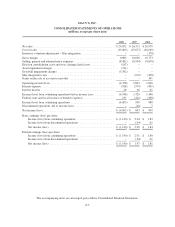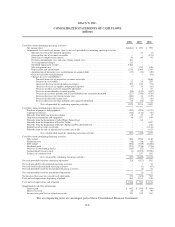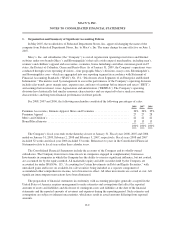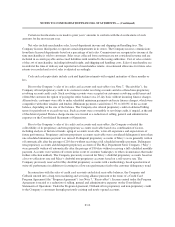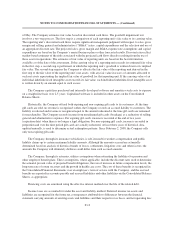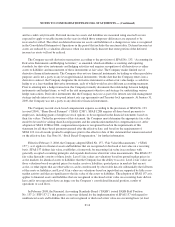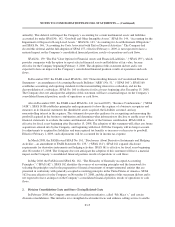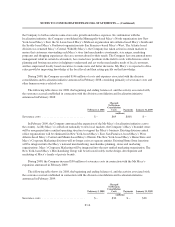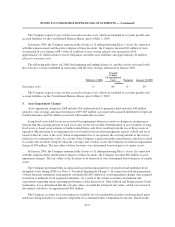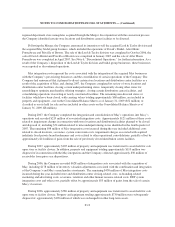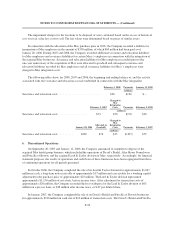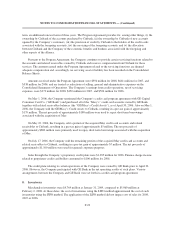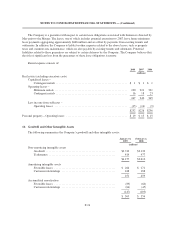Macy's 2008 Annual Report Download - page 62
Download and view the complete annual report
Please find page 62 of the 2008 Macy's annual report below. You can navigate through the pages in the report by either clicking on the pages listed below, or by using the keyword search tool below to find specific information within the annual report.
NOTES TO CONSOLIDATED FINANCIAL STATEMENTS — (Continued)
and tax credit carryforwards. Deferred income tax assets and liabilities are measured using enacted tax rates
expected to apply to taxable income in the years in which those temporary differences are expected to be
recovered or settled. The effect on deferred income tax assets and liabilities of a change in tax rates is recognized
in the Consolidated Statements of Operations in the period that includes the enactment date. Deferred income tax
assets are reduced by a valuation allowance when it is more likely than not that some portion of the deferred
income tax assets will not be realized.
The Company records derivative transactions according to the provisions of SFAS No. 133, “Accounting for
Derivative Instruments and Hedging Activities,” as amended, which establishes accounting and reporting
standards for derivative instruments and hedging activities and requires recognition of all derivatives as either
assets or liabilities and measurement of those instruments at fair value. The Company makes limited use of
derivative financial instruments. The Company does not use financial instruments for trading or other speculative
purposes and is not a party to any leveraged financial instruments. On the date that the Company enters into a
derivative contract, the Company designates the derivative instrument as either a fair value hedge, a cash flow
hedge or as a free-standing derivative instrument, each of which would receive different accounting treatment.
Prior to entering into a hedge transaction, the Company formally documents the relationship between hedging
instruments and hedged items, as well as the risk management objective and strategy for undertaking various
hedge transactions. Derivative instruments that the Company may use as part of its interest rate risk management
strategy include interest rate swap and interest rate cap agreements and Treasury lock agreements. At January 31,
2009, the Company was not a party to any derivative financial instruments.
The Company records stock-based compensation expense according to the provisions of SFAS No. 123
(revised 2004), “Share-Based Payment” (“SFAS 123R”). SFAS 123R requires all share-based payments to
employees, including grants of employee stock options, to be recognized in the financial statements based on
their fair values. Under the provisions of this statement, the Company must determine the appropriate fair value
model to be used for valuing share-based payments and the amortization method for compensation cost. After
adoption of SFAS 123R in 2006, compensation expense is recognized based on the requirements of this
statement for all share-based payments granted after the effective date, and based on the requirements of
SFAS 123, for all awards granted to employees prior to the effective date of this statement that remain nonvested
on the effective date. See Note 16, “Stock Based Compensation,” for further information.
Effective February 3, 2008, the Company adopted SFAS No. 157, “Fair Value Measurements,” (“SFAS
157”), as it applies to financial assets and liabilities that are recognized or disclosed at fair value on a recurring
basis. SFAS 157 defines fair value, establishes a framework for measuring fair value in accordance with
generally accepted accounting principles and expands disclosures about fair value measurements. The SFAS 157
fair value hierarchy consists of three levels: Level 1 fair values are valuations based on quoted market prices in
active markets for identical assets or liabilities that the Company has the ability to access; Level 2 fair values are
those valuations based on quoted prices for similar assets or liabilities, quoted prices in markets that are not
active, or other inputs that are observable or can be corroborated by observable data for substantially the full term
of the assets or liabilities; and Level 3 fair values are valuations based on inputs that are supported by little or no
market activity and that are significant to the fair value of the assets or liabilities. The adoption of SFAS 157 as it
applies to financial assets and liabilities that are recognized or disclosed at fair value on a recurring basis did not
have and is not expected to have an impact on the Company’s consolidated financial position, results of
operations or cash flows.
In February 2008, the Financial Accounting Standards Board (“FASB”) issued FASB Staff Position
No. 157-2 (“FSP 157-2”) that permits a one-year deferral for the implementation of SFAS 157 with regard to
nonfinancial assets and liabilities that are not recognized or disclosed at fair value on a recurring basis (at least
F-14



